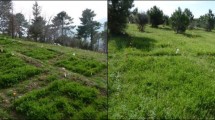Abstract
Seeking an alternative to Sesbania spp. tree fallows, a Tephrosia species and provenance trial was conducted at Msekera Research Station, Chipata (Zambia) to evaluate eleven Tephrosia vogelii and three Tephrosia candida provenances. They were tested for biomass production, quality of biomass, resistance to root-knot nematodes, nitrogen release, and for their effects on soil nitrogen dynamics. At the end of 1.5 years, the T. candida provenances 02970, 02971 and 02972 from Madagascar produced two times greater amount of aboveground biomass than the T. vogelii provenances. There was little variability among the T. vogelii provenances in terms of litter and biomass production. Weed growth was significantly greater under T. vogelii than T. candida provenances. While Tephrosia vogelii provenance 98/02 from Zambia and T. candida 02972 were highly tolerant to the Meloidogyne incognita nematodes, T. vogelii provenances 02977, 98/03, 02973 from Kenya, Zambia and Malawi, respectively, were highly susceptible to the nematodes. The Tephrosia species and provenances showed a wide variability in terms of N, lignin and polyphenol concentration in their foliage. Mineralization of N in the foliage of T. candida provenances 02970 and 02971 and T. vogelii provenances 98/04 and 02974 from Malawi occurred rapidly within 14 weeks of incubation. At the end of the 2-year growth period, there was significantly greater total inorganic N under T. candida provenance 02972 (12.5 mg kg−1) than T. vogelii (5 mg kg−1) provenance Mungwi 98/02. Maize (Zea mays L.) yields after T. candida provenances were greater than those after T. vogelii provenances. Further testing of the most promising provenances is needed for their effects on subsequent maize yields under a range of farm conditions.
Similar content being viewed by others
References
Bridge J. and Page S.L.P. 1980. Estimation of rootknot nematode infestation on roots using a rating chart. Tropical Pest Management 26: 196–299.
Desaeger J. and Rao M.R. 2000. Parasitic nematode populations in natural fallows and improved cover crops, and their effects on subsequent crops in Kenya. Field Crops Research 65: 41–56.
Desaeger J. and Rao M.R. 2001. The potential of mixed covers of Sesbania, Tephrosia and Crotalaria to minimize nematode problems on subsequent crops. Field Crops Research 70: 111–125.
Franzel S., Phiri D. and Kwesiga F.R. 2002. Assessing the adoption potential of improved fallows in eastern Zambia. In: Franzel S. and Scherr S.J. (eds.), Trees on the Farm: Assessing the Adoption Potential of Agroforestry Practices in Africa. CAB International, Wallingford, UK, pp. 37–64.
ICRAF 1995. Annual Report. International Centre for Research in Agroforestry, Nairobi, Kenya.
Kwesiga F. 1994. Performance of fifteen provenances of Gliricidia sepium in eastern Zambia. Forest Ecology and Management 64: 161–170.
Kwesiga F. and Coe R. 1994. Potential of short rotation sesbania fallows in eastern Zambia. Forest Ecology and Management 64: 161–170.
Kwesiga, F.R., Franzel, S., Place, F., Phiri, D. and Simwanza, C.P. 1999. Sesbania sesban improved fallows in eastern Zambia: Their inception, development and farmer enthusiasm. Agro-forestry Systems 47: 49–66.
Mafongoya P.L., Barak P. and Reed J.D. 2000. Carbon, nitrogen and phosphorus mineralization of tree leaves and manure. Biology Fertility of Soils 30: 298–305.
Mafongoya P.L., Giller K.E. and Palm C.A. 1998. Decomposition and nitrogen release patterns of tree prunings and litter. Agroforestry Systems 38: 77–97.
Mafongoya P.L. and Dzowela B.H. 1999. Biomass production of tree fallows and their residual effect on maize in Zimbabwe. Agroforestry Systems 47: 139–151.
Niang A., Amadalo B.A., de Wolf J. and Gathumbi S.M. 2002. Species screening for short term planted fallows in the highlands of western Kenya. Agroforestry Systems 56:145–154.
Palm C.A. and Sanchez P.A. 1991. Nitrogen release from the leaves of some tropical legumes as affected by their lignin and polyphenolic contents. Soil Biology and Biochemistry 23: 83–88.
Palm C.A., Gachengo C.N., Delve R.J., Cadisch G. and Giller K.E. 2001. Organic inputs for soil fertility management in tropical agroecosystems: Application of an organic resource database. Agriculture, Ecosystems and Environment 83: 27–42.
Reed J.D., Horvath P.J., Allen M.S. and van Soest P.J. 1985. Gravimetric determination of soluble phenolics including tannins from leaves by precipitation with trivalent ytterbium. Journal of the Science of Food and Agriculture 36: 255–261.
Snapp S.S., Mafongoya P.L. and Waddington S. 1998. Organic matter technologies for integrated nutrient management in smallholder cropping systems of southern Africa. Agriculture, Ecosystems and Environment 71: 185–200.
Sileshi G., Ogol C.K.P.O., Sithanantham S., Rao M.R., Baumgartner J., Maghembe J.A. and Mafongoya P.L. 2001. Resistance of Sesbania accessions to Mesoplatys ochroptera Stål (Coleoptera: Chrysomelidae). Insect Science and Applications 21: 139–153.
Author information
Authors and Affiliations
Corresponding author
Rights and permissions
About this article
Cite this article
Mafongoya, P., Chintu, R., Chirwa, T. et al. Tephrosia species and provenances for improved fallows in southern Africa. Agroforestry Systems 59, 279–288 (2003). https://doi.org/10.1023/B:AGFO.0000005228.57515.54
Issue Date:
DOI: https://doi.org/10.1023/B:AGFO.0000005228.57515.54




